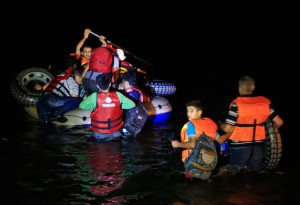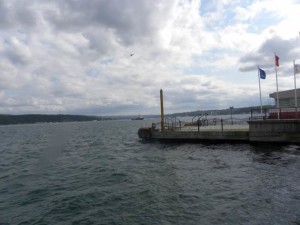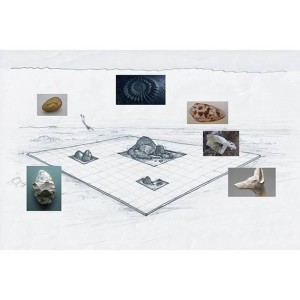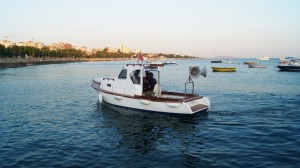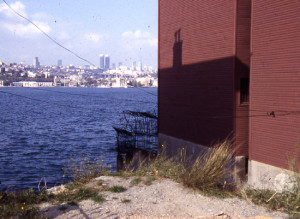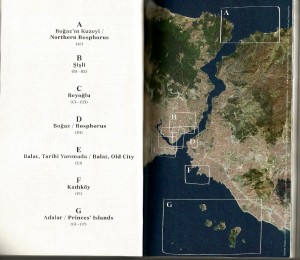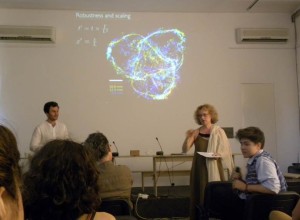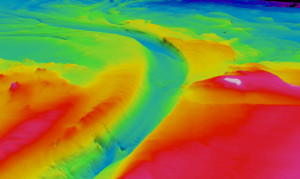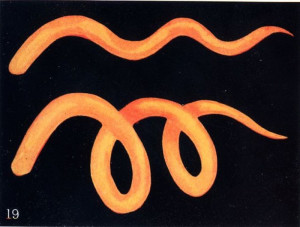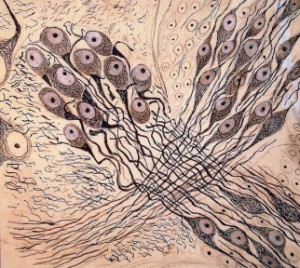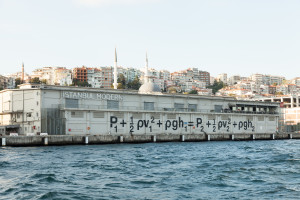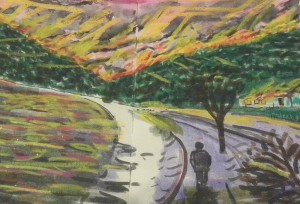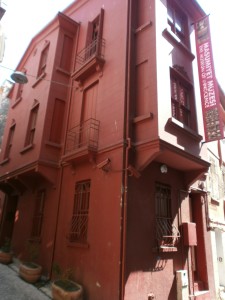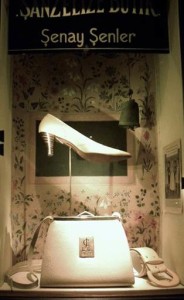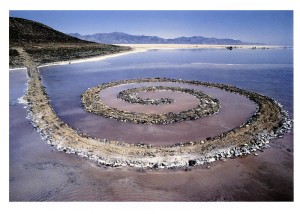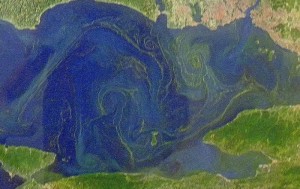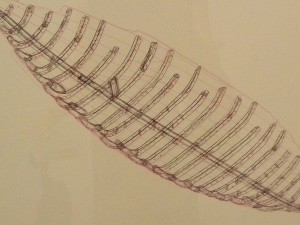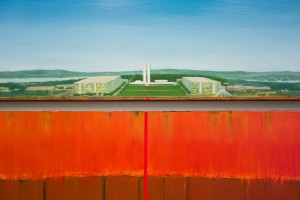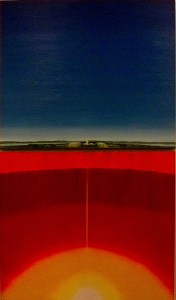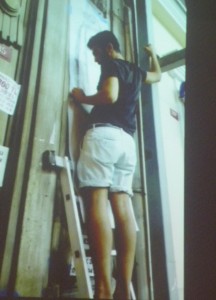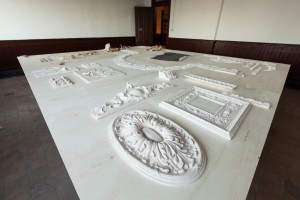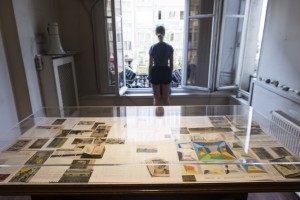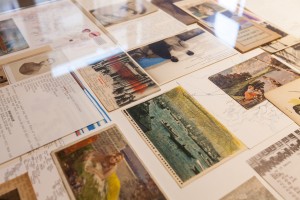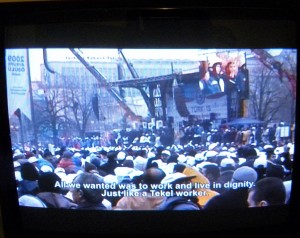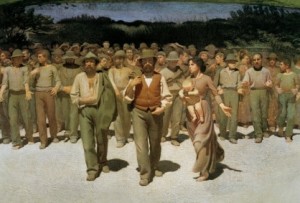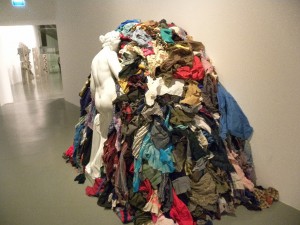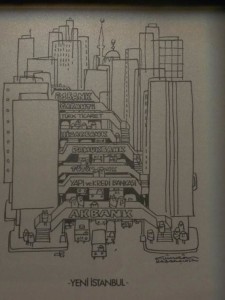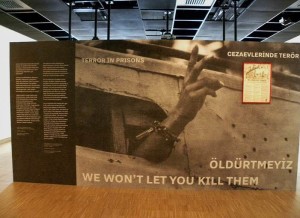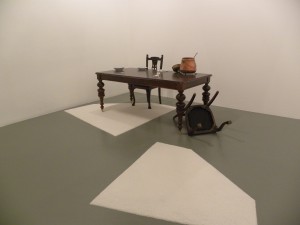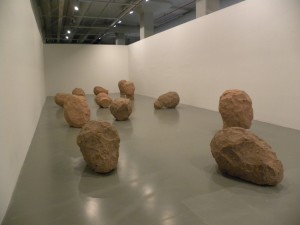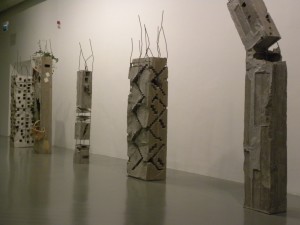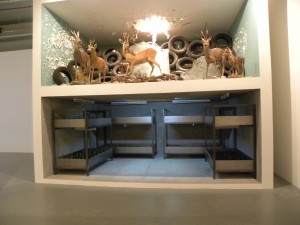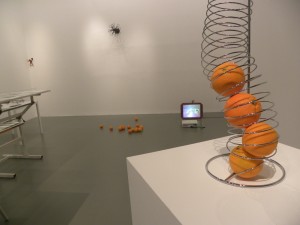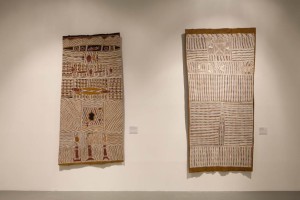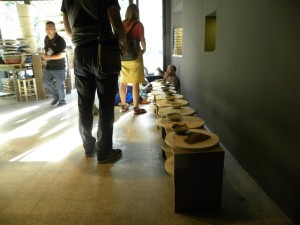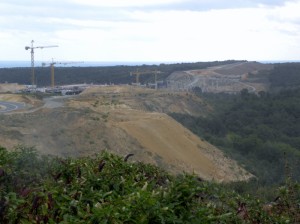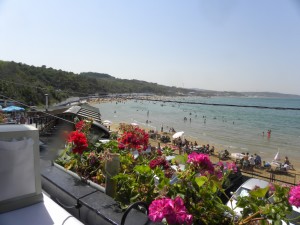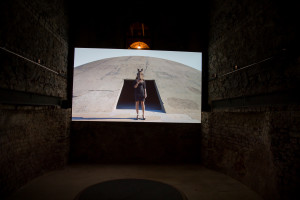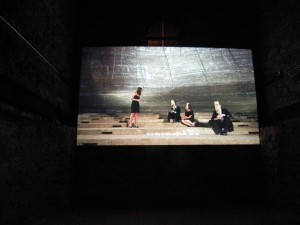“Tuzlu Su” “Saltwater” Istanbul Biennial 2015
Against the backdrop of Turkey’s intense political realities, horrifying bombings at peace rallies, and other acts of violent nationalism, as well as an urgent migration crisis (as it opened, we witnessed on television thousands of desperate refugees leave Bodrum on the coast of Turkey packed onto rubber rafts for a four hour trip to Kos and Lesbos, (nearby Greek Islands).
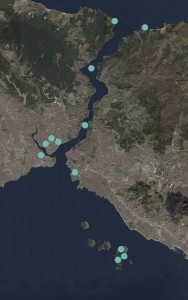
“Tuzlu su” “Saltwater: A Theory of Thought Forms,” the 14th Istanbul Biennial, appears innocuous. It features mysterious venues that cannot be seen, installations in obscure cisterns, former bank vaults, and about to be torn down garages and houses, as well as trips to the Sea of Marmara Princes Islands and up the Bosphorus to simply view a lighthouse with a Lawrence Weiner graphic image and a Cold War radar antenna.
Under the Sea of Marmara, entirely invisible to us, Pierre Huyghe’s “Abyssal Plain. Geometry of the Immortals” located near the inaccessible island of Sivriada, is a “concrete stage …around existing rock formations on the bottom of the Sea of Marmara….over the next few years it will become a platform for objects taken from the surface, production left over from the history of the Mediterranean region, including the artists own production.” Through the power of natural currents, the existing creatures of the sea will join the human artefacts on the “stage.” More about those currents soon, they are a major feature of the Biennial.
Not invisible but inaccessible was Fusun Onur’s fishing boat with loudspeakers with a recording of a woman reciting passages from the Odyssey. As you see below, Füsun Onur’s house is almost in the Bosphorus, and her entire life has been spent very close to it, so she has always had a relationship with it unlike any other.
The Istanbul Biennial this year is an exhibition of cloaked intent.
Just as the Bosphorus itself hides histories of wrecks, and unimaginably early settlements only recently discovered, so this Biennial hides its urgent politics and radical thinking. Only by close attention and excavation does the urgency of the exhibition become clear.
The Biennial includes a total of 1500 artworks in 36 venues; it was impossible for anyone to visit all of them. I chose to view the larger exhibitions, and a selection of art on display in houses, galleries, boutique hotels, and other venues in the center of the city, all of them privately sponsored spaces, a significant aspect of the cloaking of the Biennial from government scrutiny.
The intent of the organizer, Carolyn Christov-Bakargiev, who refers to her role as drafting a “Composition,” takes on the metaphor of saltwater as a synonym for “transformation and change on the planet . . .It is a theory of life. “ Christov-Bakargiev does not believe in separating art and science, of creating boxes for different types of thinking. Flow of water is equated in her mind to flow of ideas, waves to waves of resistance and outrage, knots to arrested movement. She sees art as an empathic political statement in conflict with art as capitalism. (Here come the cloaked politics.)
As a result, she included physicist William Irvine who explores knots inside water, and oceanographers Emin Özsoy and Jeffrey Peakall who study underwater rivers as part of “The Channel,” a segment of the Biennial located in the Istanbul Modern Museum.
A stunning video of the Bosphorus, taken by a submarine, demonstrates the enormous power of an underwater river flowing into the Black Sea, in the opposite direction from the surface flow. For this Biennial it stands as a metaphor for a powerful, but hidden, form of resistance to the surface of society. The deep grassroots activism of artists can change the course of the social forces of society in the view of Christov-Bakargiev. She believes that all art is political.
Christov-Bakargiev erased as many borders as she could, media, time, place, genre, political, aesthetic.
She is inclined to the mystical as well as the scientific, particularly to those who make the invisible into abstract expressions, so she included drawings such as the familiar “thought forms” of Anne Besant and Charles Leadbetter, as well as images created by physicist Giovanni Anselmo,
neuroscientist Santiago Ramon y Cajal (above) , the mathematician Fredrik Carl Mulertz Stormer, then continuing to the present with Lawrence Weiner’s calligraphic gesture and Liam Gillick who painted the formula known as Bernoulli’s principle that as pressure decreases, speed increases on the outside of the Modern Museum.
Visual work by writers, like Orhan Pamuk’s notebooks with watercolor sketches, also crossed media boundaries. Pamuk’s Museum of Innocence, another Biennial site, literally materialized his novel of the same name, displaying artifacts of the lives of 1950s and 1960s elites, organized by the chapters of his novel and obfuscating fiction and reality. The entire collection inside, randomly collected by Pamuk was attributed to the fictional family of the novel. As he collected the artifacts, it also stimulated what he wrote.
“The Channel” galleries of the exhibition, near the entrance, encapsulated the flow of metaphors in “Tuzlu Su” as a whole “representing both the Bosphorus and the ‘sodium channel of our neurons, a passageway in the membrane of these cells that lets only sodium ions pass through.” 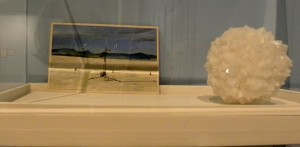
Tacita Dean’s “Salt(A collection)” greeted us with a good sized ball crystallized in potash, a wonderfully physical manifestation of salt, and painted over postcards of the Salt Lake, all referring to her attempt to visit Robert Smithson’s Spiral Jetty in 1997. The original “Spiral Jetty” film is at the very back of the exhibition marking a primal inspiration for the exhibition as a whole. It partners with an unlabeled video in the Channel of Christov-Bakargiev visiting the site of the Jetty.
As explained long ago by the wonderful art critic John Coplans, Smithson’s sees geology and human thought as aligned. The spiral is relates to entropy and irreversibility, “ a spiral vectors outward and simultaneously shrinks inward – a shape that circuitously defines itself by entwining space without sealing it off.”
The themes of time, entropy, and the return to the earth of what we make are central to Smithson’s thinking,and make it a perfect starting point for the Biennial itself. On the other hand, when I viewed the dinosaur like back hoe creating the jetty in the film, it felt destructive and aggressive. Smithson turned shortly after Jetty to reclamation rather than construction, to working with the land, rather than on it. To working to remediate the destruction of industry. How much we need him today!
Also at the entrance of the Channel was Emin Özsoy’s scientific photograph of currents in the Sea of Marmara, and beside it
Ufuk Kocabaş’s 3d digital print based on one of the 37 Byzantine shipwrecks found in the bottom of the Bosphorus during excavation for a tunnel. We move on to a book by Darwin “On the various contrivances By which British and Foreign Orchids are Fertilized
by insects and on the Good effect of Intercrossing” 1862, an example of the intersections that occur throughout the Biennial.
I am enumerating all of this because it gives a sense of the flow of media, ideas, and connections that materializes the idea of waves and knots in saltwater. The aesthetics of the exhibition forms in our mind as we move from one work to the next.
Some of course are more impressive than others, such as Cildo Meireles’ stunning two part painting with 3 cm in between “Project Hole to Throw Dishonest Politicians.” That 3 cm separates the world of bureaucracy and earth’s forces.
This Biennial honored the 100th anniversary of the Armenian genocide in Turkey in several ways. Michael Rakowitz installation in the former Greek Primary School, a casualty of the declining Greek population in Istanbul. His installation included casts of patterns created by Armenian architects on many buildings in central Istanbul. He used crushed bones to create the casts of the fragments based on still existing molds. The bones came from the dead livestock of an Armenian village, and from dogs from the island of Sivriada where 80,000 dogs were sent to die in 1911 in an effort to modernize Istanbul, the first holocaust of the twentieth century. Cultural artifacts here are architectural pentimenti of tragedy. You can still see these ornamental patterns on many buildings in Central Istanbul.
Rene Gabri and Ayreen Anastas referred to the endangered position of Armenians today: they created a Center for Parrhesia for the Society of the Friends of Parrhesia “one who speaks the truth ” or “free speech” at the foundation created in the offices of the Armenian journalist Hrant Dink, murdered in 2007. Their space is intended for “thinking how to become worthy of what we inherit as ‘history and to what happens to us. “ As a center for free speech, it is, of course, unfortunately dangerous in contemporary Turkey. Erdogan has been jailing journalists, taking over opposition newspapers, and repressing freedom of speech in an escalating campaign to control what is said in Turkey
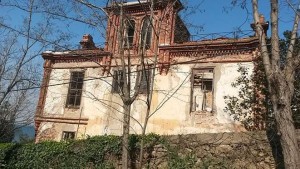
But aside from the theme of saltwater, waves and knots themselves, the Biennial takes on their metaphors as well such as Resistance as a knot. That is documented by including the Arabic translation of Trotsky’s 1928 text, the Real Situation in Russia, aggressively rebutting Stalinism. It is owned by Christov-Bakargiev. In 1929-33 Trotsky was in exile on the island of Buyukada, without a country. Trotsky’s socialism is important as suggested in Christov-Bakargiev’s comments on the conflict of art that engages issues and the commericialism of the art world. But one might also think of the current situation in Turkey in terms of Stalinist-like repressions by the government.
Perfectly appropriate then that the now- ruined house where he stayed for several years on the Princes Island is a destination for Biennial visitors (along with various installations inside other houses and hotels, as well as a boat, none of which I was able to get to see.)
Camouflaged references to the Gezi uprising of 2013 appeared in various ways if you knew where to look. One room at the Istanbul Biennial included Artiksler Kolektifi’s video documenting the 2010 workers resistance in Ankara.https://bak.ma/
It faced a copy painted by Taner Ceylan of a very large 1901 painting of The Fourth Estate by Giueseppe Pellizz da Volpedo. It is described in the catalog as “a key image for socialist and democratic movements worldwide. A peaceful but energized crowd of protesters in a rural town advances towards the viewer in the morning light of a rising sun. They form a wave and they are full of confidence. They come for their rights. “ An indirect reference to the Gezi uprising?
In the same gallery with the Volpedo and the Artiksler Kolecttifi video was the historical work by Michelangelo Pistoletto Venus of the Rags from 1967, a vivid confrontation of the elite and disenfranchised. Making the Gezi connection explicit, Tunca Subasi and Cagri Saray, in their studio buried deep on the Asian side of the Bosphorus, exhibited a collage of Gezi Park footage created by Ozge Celikasian and Alper Sen (also viewable online at https://bak.ma/.)
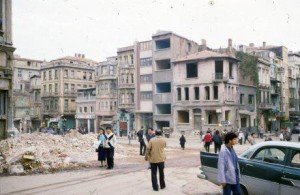
Amplifying the references to public protest , the gallery SALT Beyoğlu in central Istanbul created an archival exhibition “Nerden Geldik Buraya? (How did we get here?)” focusing on 1980s resistance to the military coup, along with protests about unfair imprisonment ( below, “We won’t let them kill you”, urban development “Yeni Istanbul”, the environment and free speech issues of those years. It charted, as the curator stated “the origins of the current context of Turkey at this turning point, in relation to the recent past and via elements of popular culture and social movements that took hold after the coup d’état in 1980.”
One striking newspaper article from the Nation featured a letter by Arthur Miller visiting Turkey stating international support for imprisoned journalists. Would we could have contemporary celebrities calling attention to the many journalists and academics currently detained in Turkey
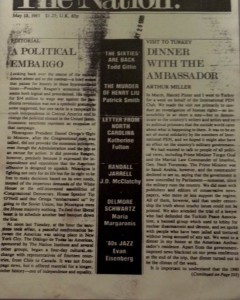
Arthur Miller article in The Nation “Dinner with the Ambassador” as he visited Turkey to support imprisoned journalists
.
Once we recognize the cloaked resistance we can see resistance and opposition as well as grassroots collaboration in many works in the Biennale. What begins as a ferry ride to appreciate salt water, becomes an intense layered reference to art as resistance to capitalism and the status quo. This Biennial, like the Bosphorus itself, hides itself in layers of references.
Many resonant works contributed to these layers. One of the more disorienting in the Istanbul Modern, Grace Schwindt’s installation Little Birds and a Demon captivated me. A voice precisely narrated the nightmarish condition of birds caught in an oil spill, as we viewed her seemingly unrelated off kilter installation: two irregularly geometric salt “carpets,” a table with one leg on the salt. On it are a copper cauldron filled with what is called “used-pointe-ballet-shoe-soup” and a ladle, soup bowls, a stack of silver spoons, two chairs.
Nothing makes sense, it entirely disrupts our sense of the rational and how to connect it to oiled birds? Their lives are overturned, like the bourgeois setting of the installation? Schwindt caustic comments on the corrosive effects of capitalism: “There is a very limited possibility of freedom in capitalism, because you never reach promise, and that’s my point.” So perhaps lack of predictable action is both for the oiled birds and the residents of the room. The assymetrical salt shapes represent the mining of the earth resources that kills or maims the people living on it.
Near the installation by Scwindt, a roomful of roughly carved stone heads Silence of Stones by Sonia Balassanian. These twelve partially carved heads evoke erasure and suffering, through their unfinished surfaces and somehow through the way they are placed in the space. There is separation between them that seems to prevent any connection. Balassanian again connects to the Armenian genocide, the stone is from Ani, a town in Armenia, but the subtlety of the carving suggests a universal, almost classical angst, like Michelangelo’s late works.
Lebanese artist Marwan Rechmaoui’s 14 ruined towers of concrete “Pillar series” immediately speak of war and destruction: improvised from what appear to be remnants of buildings, the textures and patterns carefully drawn from believable architectural motifs, but at the same time they exist as aesthetic supports created out of desperation, creating a type of concrete garden that recalls the words of Vita Sackville West quoted at the beginning of the exhibition: “Small pleasures must correct great tragedies, therefore of gardens in the midst of war I bold tell.”
Nikita Kadan’s, the Shelter, also called Untitled (Political Natural History Department) makes provocative reference to destruction of museums of natural history during the Ukrainian war. Kadan states “In this period of Ukrainian life, the position of a citizen, a normal citizen, and the position of an activist have become very close . . . To be a conscious citizen means to be a social-political activist now.” His two part work features (seemingly disoriented) artificial deer who have emerged from their dioramas into the street, behind them are the rubber tires used as barricades in Kiev, and below, cases growing celery in the dark, suggesting subsistence survival.
Speaking of surviving social structures, the installation by Senam Okudzeto Glossolalia no 12, part of an ongoing project called “Portes Oranges,” celebrates women’s economy, particularly through the sale of oranges, and the sculptural displays created in Ghana.
Also addressing positive outcomes was the amazing group of Australian aboriginal paintings that demonstrated ownership of the land and sea.
In another venue an installation by Inland diagrams their connections to artists, farmers, intellectuals,rural development agents, policymakers, curators and art critics,amongst others. In Istanbul, it joined with rural groups in Turkey Alternatif Uretim near Diyabakir and Ularca (Soma).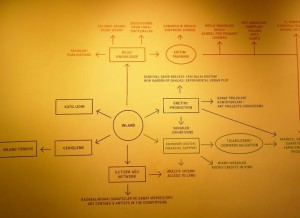
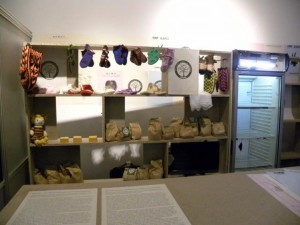
Theaster Gates “Three or Four Shades of Blue” inspired by Iznik pottery was a “store” where he created bowls made of dust taken from resonant sites in the city. Gates interacted with the public , you can just see him sitting on the floor in the background.
(upstairs were videos of jazz singers).
At the end of my trip, I had the opportunity to travel up the Bosphorus to the Black Sea, although my experience was quite different from the intended relaxing ferry rides on salt water. From the land I saw the devastation of acres of precious forests caused by the construction of the controversial Third Bridge, new airport, and superhighways, even including the boom of a dynamite blast that sent a cloud of smoke into the air.
I saw families who had braved hours of traffic jams to enjoy a very hot afternoon wading in the Black Sea, and
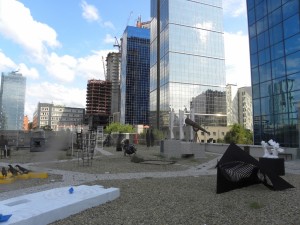
I experienced the high rises of contemporary Istanbul. This is the reality of Istanbul today, a long way from the languorous ferry rides and borderless utopian world imagined by the Biennial.
Perhaps for that reason my favorite work was a video by Pelin Tan and Anton Vidolke A science fiction fantasy Episode 2 The Fall of the Artists Republic. In the intentional contradictions that filled the Biennale, it was shown in a cistern under a boutique hotel in the center of old Istanbul.
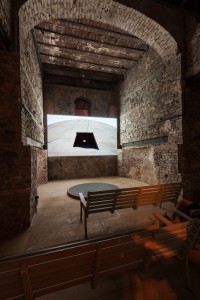
The video itself was filmed in an abandoned dome building in Beirut that is part of the former Rashid Karami International Fair Complex designed by Oscar Niemeyer from 1962 – 1974.Five people with dog, chicken and horse masks, as well as a human, recited the story of the Fall of the Artists Republic. It recounts a great people’s uprising that led to remaking the world; they made “art so beautiful that people became animals.” Feeling became the economic resource, but the great utopian experiment failed, leaving only these few creatures inside an abandoned utopian structure.
The Biennial’s originality, complexity, and refusal to settle for predictability, made it one of the best international exhibitions I have seen in many years.
This entry was posted on October 15, 2015 and is filed under Istanbul Biennial, Istanbul Biennial 14, Turkish Women Artists, Uncategorized.

